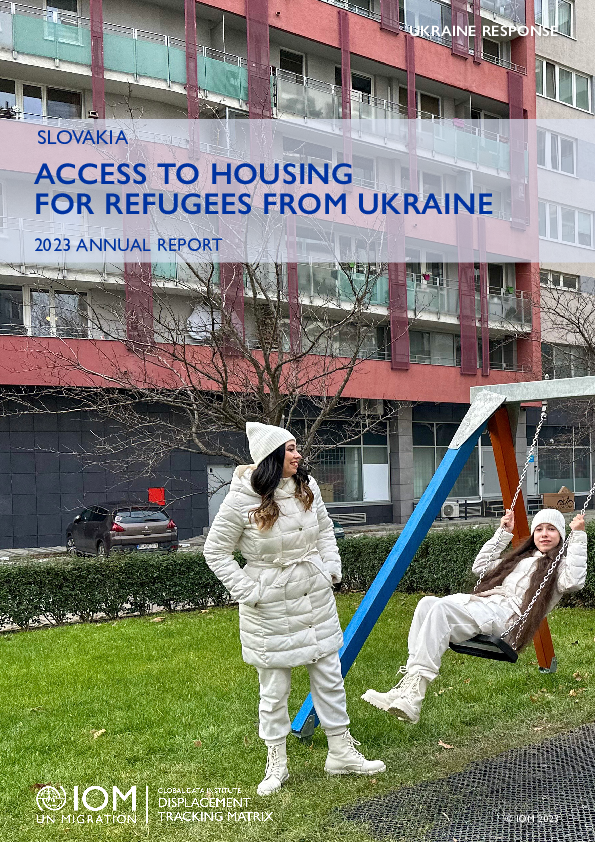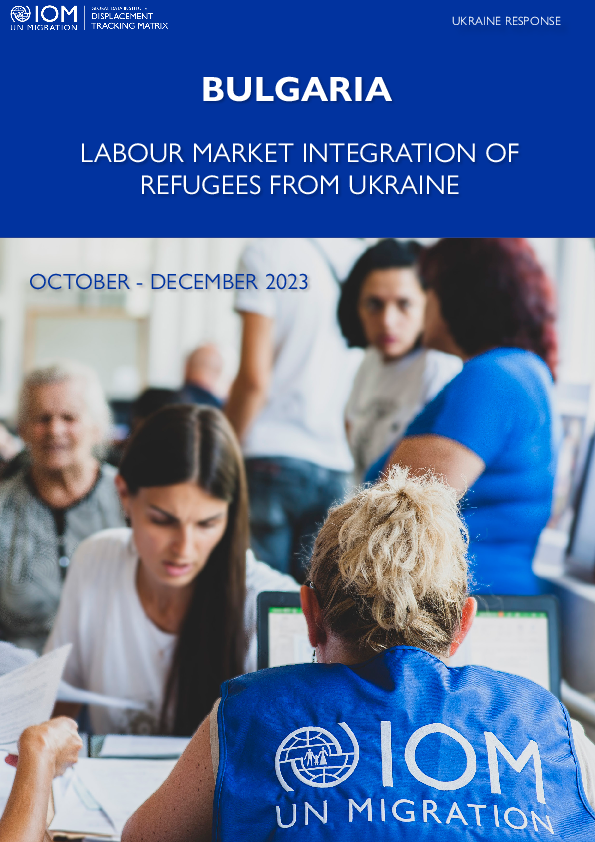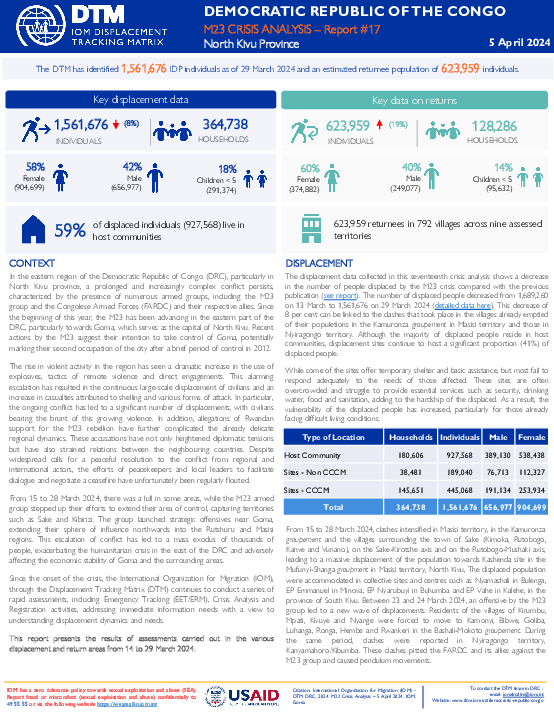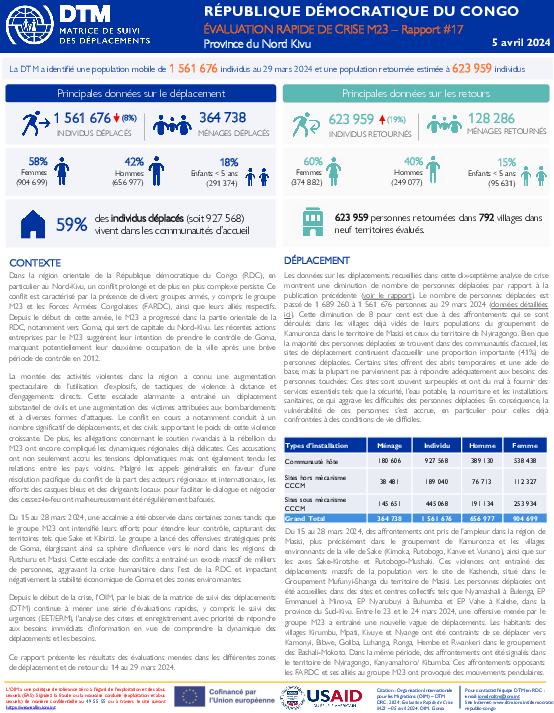-
Countries
-
Data and Analysis
-
Special Focus
-
Crisis Responses

Contact
DTM Djibouti, DTMDjibouti@iom.int
Language
English
Location
Djibouti
Period Covered
Jan 01 2024
Jan 31 2024
Activity
- Flow Monitoring
In January 2024, 26,992 migratory movements were observed at all Djibouti's Flow Monitoring Points (FMPs) with a decrease of 9 per cent compared with December 2023. This drop is linked to the controls carried out on certain migration routes by the Djibouti authorities. During the same period in January, the number of people entering Djibouti from Ethiopia rose by 14 per cent compared with December 2023, mainly due to the temperatures which migrants consider to be favourable for taking the migration route at this time of year. During January, the number of spontaneous or forced returnees recorded in the Obock and Tadjourah regions almost tripled, rising from 286 in December 2023 to 775 in January 2024, mainly due to controls by the authorities on the Yemeni coast.

Contact
DTM Europe, DTMMediterranean@iom.int
Language
English
Location
Slovakia
Period Covered
Jan 01 2023
Dec 31 2023
Activity
- Survey
Key findings:
- 67% of respondents were living in individual housing and 33% in collective housing
- 16% of households had at least one infant (0-4 years old), 45% with at least one child (5-17 years old) and 31% with at least one elderly person (60+ years old).
- 14% were in need of support with accommodation
- 18% were in need of support with household goods
- 50% of respondents changed accommodation at least once while in Slovakia
- Key challenges in accessing housing include: overcrowdedness (42%), stress (15%) and lack of privacy (10%)
- 71% of respondents have received accommodation support

Contact
DTM Europe, DTMMediterranean@iom.int
Language
English
Location
Bulgaria
Period Covered
Oct 01 2023
Dec 31 2023
Activity
- Survey
Key Findings:
- Among respondents, 57 per cent are active (employed or unemployed), and 40 per cent are inactive (student status, parental leave, retirement, unemployment and not looking for a job).
- Within active population, 51 per cent are employed and 34 are unemployed, 9% were daily workers and 6% were self-employed.
- Key occupations after displacement are in professional roles (30%), services and sales (24%) and elementary occupations (13%)
- 75% of working-age stayers do not know the local language. Among working-age stayers without any knowledge of the local language (76%), 37 per cent are employed and 59 per cent are unemployed (4% unknown).
- 71% of male respondents were satisfied and 67% of female respondents were satisfied.
- Top reasons for unemployment and not looking for a job*: family duties (63%), medical conditions (11%), no need for job (10%).

Contact
DTM DRC, iomdrcdtm@iom.int
Language
English
Location
Democratic Republic of the Congo
Period Covered
Mar 14 2024
Mar 29 2024
Activity
- Mobility Tracking
- Event Tracking
In the eastern region of the Democratic Republic of Congo (DRC), particularly in North Kivu province, a prolonged and increasingly complex conflict persists, characterized by the presence of numerous armed groups, including the M23 group and the Congolese Armed Forces (FARDC) and their respective allies. Since the beginning of this year, the M23 has been advancing in the eastern part of the DRC, particularly towards Goma, which serves as the capital of North Kivu. Recent actions by the M23 suggest their intention to take control of Goma, potentially marking their second occupation of the city after a brief period of control in 2012.
Since the onset of the crisis, the International Organization for Migration (IOM), through the Displacement Tracking Matrix (DTM) continues to conduct a series of rapid assessments, including Emergency Tracking (EET/ERM), Crisis Analysis and
Registration activities, addressing immediate information needs with a view to understanding displacement dynamics and needs. This report presents the results of assessments carried out in the various displacement and return areas from 14 to 29 March 2024.

Contact
DTM DRC, iomdrcdtm@iom.int
Language
French
Location
Democratic Republic of the Congo
Period Covered
Mar 14 2024
Mar 29 2024
Activity
- Mobility Tracking
- Event Tracking
Dans la région orientale de la République démocratique du Congo (RDC), en particulier au Nord-Kivu, un conflit prolongé et de plus en plus complexe persiste. Ce conflit est caractérisé par la présence de divers groupes armés, y compris le groupe M23 et les Forces Armées Congolaises (FARDC), ainsi que leurs alliés respectifs. Depuis le début de cette année, le M23 a progressé dans la partie orientale de la RDC, notamment vers Goma, qui sert de capitale du Nord-Kivu. Les récentes actions entreprises par le M23 suggèrent leur intention de prendre le contrôle de Goma, marquant potentiellement leur deuxième occupation de la ville après une brève période de contrôle en 2012.
Depuis le début de la crise, l'OIM, par le biais de la matrice de suivi des déplacements (DTM) continue à mener une série d'évaluations rapides, y compris le suivi des urgences (EET/ERM), l'analyse des crises et enregistrement avec priorité de répondre aux besoins immédiats d'information en vue de comprendre la dynamique des déplacements et les besoins. Ce rapport présente les résultats des évaluations menées dans les différentes zones de déplacement et de retour du 14 au 29 mars 2024.

Contact
DTM Pakistan, DTMPakistan@iom.int
Language
English
Location
Pakistan
Period Covered
Mar 16 2024
Mar 31 2024
Activity
- Flow Monitoring
The International Organization for Migration (IOM) in Pakistan collects data on the outflows of Afghans at the Torkham (Khyber Pakhtunkhwa), Badini, Bahramcha and Chaman (Balochistan) border crossing points (BCPs) to better understand the movements of Afghans returning to Afghanistan. The data presented below is harmonised with those from the United Nations High Commissioner for Refugees (UNHCR), who also cover Ghulam Khan (Khyber Pakhtunkhwa). On 26 September 2023, the Ministry of Interior in Pakistan announced its decision to enact its “Illegal Foreigners’ Repatriation Plan (IFRP)”. Between 16 and 31 March 2024, 7,532 Afghan nationals returned to Afghanistan, including 5,057 through the Torkham BCP, 1,149 through the Chaman BCP, 1326 through the Ghulam Khan BCP, while no Afghan nationals returned through the Badini BCP. In addition, border authorities deported 74 individuals due to a lack of valid documentation. Since 1 January 2024, IOM identified 54,227 returns at the four BCPs.

Contact
iomtashkent@iom.int
Language
English
Location
Uzbekistan
Period Covered
Oct 01 2023
Dec 31 2023
Activity
- Flow Monitoring Survey
- Mobility Tracking
This current report presents the latest available data on recent trends concerning migration issues in Uzbekistan, drawing upon data available for October-December 2023 and bringing major findings for the whole previous year from national and international datasets that are available to the public. The report includes recent major global and regional events that significantly impacted the migration situation in the country. The continuing impacts of the Russian invasion of Ukraine on traditional migration corridors in the region, changing labour migration flows, increase of climate change and migration concerns, the growing urbanization process, the social-economic circumstances, increased irregular migration trends and other major events are described as main contributing factors of the human mobility and migratory movements in the given period in the country. The report also gives insights into capacity-building sessions on migration data, which were provided by IOM in Uzbekistan in the given period and introduces major improvements in this direction.
Contact
dtmlebanon@iom.int
Location
Lebanon
Activity
- Mobility Tracking
- Baseline Assessment
Period Covered
Oct 10 2023 -Mar 26 2024
Since October 8 there has been an increase in cross-border incidents between Israel and Lebanon, resulting in the displacement of people both within the South and elsewhere within the country. Since October 10, the Displacement Tracking Matrix (DTM) has been conducting the daily monitoring of population movements. The objective of the exercise is to inform preparedness and response planning.
Population Groups
IDPs
Survey Methodology
Unit of Analysis Or Observation
Admin Area 2
Admin Area 3
Household
Individual
Type of Survey or Assessment
Key Informant
Keywords
Geographical Scope Full Coverage
Administrative boundaries with available data
The current dataset covers the following administrative boundaries
Contact
dtmlebanon@iom.int
Location
Lebanon
Activity
- Mobility Tracking
- Baseline Assessment
Period Covered
Oct 10 2023 -Mar 19 2024
Since October 8 there has been an increase in cross-border incidents between Israel and Lebanon, resulting in the displacement of people both within the South and elsewhere within the country. Since October 10, the Displacement Tracking Matrix (DTM) has been conducting the daily monitoring of population movements. The objective of the exercise is to inform preparedness and response planning.
Population Groups
IDPs
Survey Methodology
Unit of Analysis Or Observation
Admin Area 2
Admin Area 3
Household
Individual
Type of Survey or Assessment
Key Informant
Keywords
Geographical Scope Full Coverage
Administrative boundaries with available data
The current dataset covers the following administrative boundaries
DTM Europe gathers, validates and disseminates information on migrants and refugees travelling through the Mediterranean, Western African Atlantic, and Western Balkan routes to Europe. Key routes include:
- Eastern Mediterranean route (EMR): Bulgaria, Cyprus and Greece
- Central Mediterranean route (CMR): Italy and Malta
- Western Mediterranean route (WMR): Peninsular Coasts of Spain, Balearic Islands, Ceuta and Melilla
- Western African Atlantic route (WAAR): Canary Islands of Spain
DTM also monitors data on migrants in transit through the Western Balkans (WB) region (Albania, Bosnia and Herzegovina, Croatia, Montenegro, North Macedonia, Serbia, Slovenia, Romania, and Kosovo*). These are considered separately to prevent to the extent possible the double counting of the same persons that cross multiple borders to reach Europe.
This report presents the latest available data and trends, focusing on 2023:
- Mixed Migration Flows to Europe
- Migrant Flows Monitoring in the Republic of Türkiye
- First Arrival countries (Italy, Greece, Spain) and other countries of first arrival (Bulgaria, Cyprus and Malta)
- Transits through the Western Balkan region
- Migrants' presence, in Europe and the Republic of Türkiye
